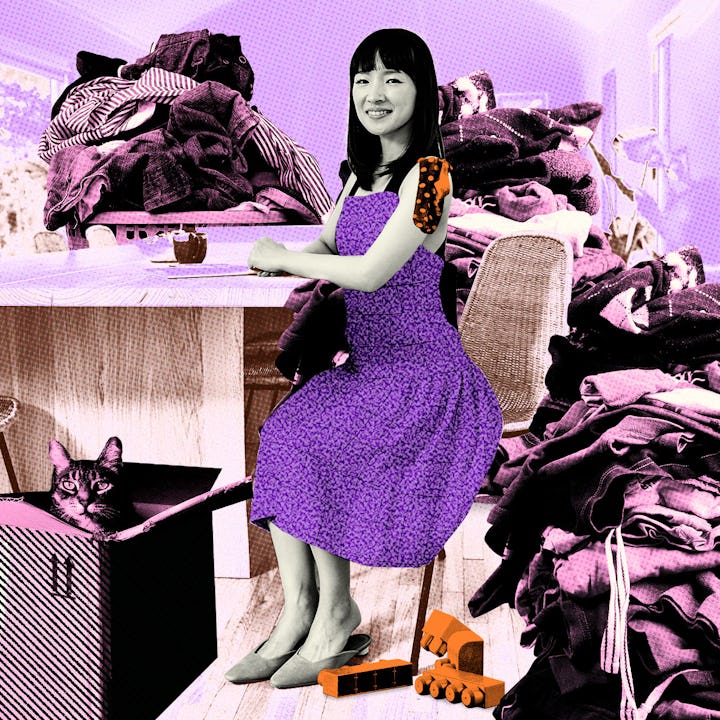Hey Marie Kondo, We Have Kid-Friendly Tidying Tips For You
We all have idyllic thoughts about parenting before the kids come — then reality hits.

Dear Marie,
Now that you have a messy house like the rest of us, we can officially welcome you to the mom club.
Your announcement that you have “kind of given up” on extreme tidiness hit the parenting world like an earthquake, but we get it. Everyone has idyllic thoughts about parenting before they have babies. Then, reality hits — and those idyllic thoughts go right into The Diaper Genie.
Here’s the thing. When a mom-club member says they have “kind of given up,” we hear you, and we rally. If tidiness is your identity, being a parent shouldn’t crush it. Kids challenge us to shift our passions, not abandon them.
We talked to parents with multiple kids and gathered the best kid-friendly cleaning hacks. We’re sharing these tips for all parents, regardless of whether they have one kid, 10 kids, or more.
Clean Up Before Eating
If the house rule is to tidy up before eating, the house gets cleaned at least three times per day.
Julie Dameron's three kids play in the living room and the dining room. She doesn't want to see toys at mealtime, so all toys must be put away before eating. "The dining room is where the kids do homework, crafts, puzzles, playdoh, legos, etc., and we set up storage that fits everything behind closed doors," Dameron says. "As I'm preparing a snack or meal, I let the kids know to start cleaning up so we can eat."
Build Habits — And Bases
With tons of kids in the house, tidying can't be casual.
Tara Furiani has seven children, so cleaning at her house is purposeful and planned. She built tidying and cleaning into her family's daily routine, and everyone participates.
"Everyone has a first base and a second base," Furiani explains. "When we're done tidying, we've hit a home run. Cheesy, I know, but whatever works with kids, right?"
First base is each family member's bedroom. They tidy while removing any trash or dishes. Second base is cleaning the rest of the house, and each child gets a job like sweeping, washing dishes, vacuuming, or organizing the toy shelves. After everyone finishes, they get a reward, which might be watching a movie, playing UNO, or singing karaoke. And a karaoke party in a house with seven siblings? Yes, please!
Cubbies and Visual Labels
Let’s face it: Little kids cannot fold clothing neatly, but they can pick it up and put it into a labeled container. In fact, it’s fun for them. Kids love sorting games.
Using labeled cubbies was a game-changer for Martina Domino, mom of three boys. “This makes putting clothes away easy and thoughtless,” she says. She has separate clothing cubbies for socks, underwear, pajamas, t-shirts, and so on. Also, they use the same technique with toy cubbies that separate legos, balls, superheroes, etc. She recommends using visual labels with pictures for younger children.
Easy Come, Easy Go
Toys accumulate easily and quickly. Try to balance that out by having them disappear — just as easily and quickly.
"A large toy might have been a hit at Christmas, but they can get over it by March," says Natalie Poston, mom of three. She wanted to make moving children's items in and out of the house easier, so she launched JoyLet, a rental service for kids' gear. For the toys in her home that are not rented, her policy is that the old must be donated to make room for the new. She involves her children in the donation process before big holidays like Christmas and birthdays.
The Open Container Law
The open container law for your house is very different from the open container law for your car. In your house, open containers are good for kids, creating an accessible, open space for them to put away toys.
"For some reason, a lid or door is enough of a barrier to putting stuff away that we've done away with them almost completely for things our kids access regularly," says Alexandra Fung, mom of four. "Now, most toys have their own basket or cubby cube, or sit on an open shelf, for easier clean up throughout the day."
Give ‘Em the Loot
Who doesn’t love praise and prizes? Heck, most of us parents would be thrilled to have someone applaud and give us a prize for cleaning the house. Well, your kids would be thrilled, too.
Praise and reward charts motivate children, says William Henry, dad of four kids. The charts create a structure to organize chores and ensure everything gets done. “I have a chart with columns for each day and rows for each chore and colorful stickers to indicate completed chores,” Henry explains. “They see their progress, and it motivates them to continue.”
Kid-Sized Organizational Systems
Kids can only help with tidying if they are able to reach storage spaces. With a bit of planning, children can learn to stay organized on their own.
”When tidying with kids, it’s important that organizational systems are set up to support them with their increasing independence,” says Tyler Moore, dad of three girls. He has low hooks for their jackets and backpacks, a bottom drawer for their plates and dishes, low clothing hangers in the closet, and bedside bags to prevent their books from ending up on the floor.
It Takes a Village to Clean a House
If it takes a village to raise a child, perhaps it also takes a village to clean that child’s house. Do not be embarrassed to ask for help!
With three children and a job, Taran Conwell needs help to get it all done. “Build that village,” Conwell says. She uses a part-time nanny who likes to clean but also recommends leaning on your spouse, family, friends, or a mother’s helper.